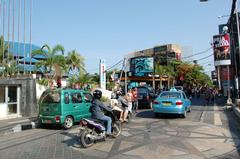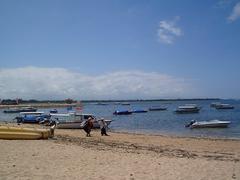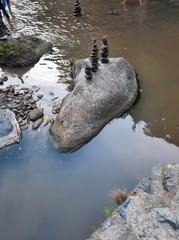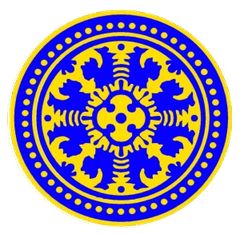Agung Rai Museum of Art Visiting Hours, Tickets, and Travel Tips
Date: 20/07/2024
Introduction
Nestled in the cultural heart of Bali, the Agung Rai Museum of Art (ARMA) in Ubud offers visitors a unique blend of art, culture, and history. Founded by Agung Rai in 1996, the museum serves as a sanctuary for both traditional and contemporary Balinese art, aiming to preserve and promote Balinese culture through its extensive collection of artworks, cultural performances, and educational programs (source). Often mistaken as being located in Denpasar, ARMA’s actual location in Ubud makes it a prime destination for those looking to immerse themselves in the rich cultural landscape of Bali. This comprehensive guide will walk you through the museum’s history, visitor information, travel tips, and its broader cultural significance, ensuring you make the most of your visit to this iconic institution.
Table of Contents
- Introduction
- History of Agung Rai Museum of Art
- Visitor Information
- Travel Tips
- Collection Highlights
- Cultural Significance
- Educational Programs
- International Collaborations
- Preservation Efforts
- Visitor Experience
- Impact on the Community
- Future Plans
- FAQ
- Conclusion
Discover the Agung Rai Museum of Art - History, Visitor Tips, and Cultural Significance
History of Agung Rai Museum of Art
Founding and Vision
The Agung Rai Museum of Art (ARMA) was founded in 1996 by Agung Rai, a Balinese entrepreneur and art enthusiast. Agung Rai’s vision was to create a space that not only showcased Balinese art but also served as a cultural hub for education and preservation of Balinese heritage. The museum is located in Ubud, Bali, not Denpasar, which is a common misconception. Ubud is known as the cultural heart of Bali, making it an ideal location for such an institution.
Early Development
The establishment of ARMA was a significant milestone in the preservation of Balinese art and culture. Agung Rai’s passion for art began in his youth, and he spent years collecting artworks and artifacts. His collection grew to include traditional Balinese paintings, contemporary works, and pieces from other parts of Indonesia. The museum’s early development was supported by various local and international artists, as well as cultural organizations that recognized the importance of preserving Balinese art.
Architectural Design
The architectural design of ARMA is a blend of traditional Balinese and modern styles. The museum complex spans over six hectares and includes exhibition halls, open stages, and lush gardens. The design reflects the Balinese philosophy of harmony with nature, and the buildings are constructed using local materials and traditional techniques. The museum’s layout is intended to provide a serene and immersive experience for visitors, allowing them to appreciate the art in a tranquil setting.
Visitor Information
- Opening Hours - ARMA is open daily from 9:00 AM to 6:00 PM.
- Ticket Prices - Admission fees are IDR 80,000 for adults and IDR 50,000 for children under 12. Tickets can be purchased at the entrance or online via their official website.
- Guided Tours - Knowledgeable guides provide insights into the artworks and the history of Balinese art. Tours are available in multiple languages.
- Accessibility - The museum is wheelchair accessible, with ramps and designated pathways.
Travel Tips
- Getting There - ARMA is located in Ubud, approximately 1.5 hours from Ngurah Rai International Airport in Denpasar. Taxis and ride-sharing services are readily available.
- Nearby Attractions - While in Ubud, consider visiting other cultural sites such as the Sacred Monkey Forest Sanctuary and the Ubud Palace.
- Best Time to Visit - Mornings are less crowded and provide a peaceful environment to explore the museum.
Collection Highlights
ARMA’s collection is diverse and extensive, featuring works from various periods and styles. Some of the notable pieces include:
- Classical Kamasan Paintings - These traditional Balinese paintings are characterized by their intricate details and narrative style. They often depict scenes from Hindu epics such as the Ramayana and Mahabharata.
- Works by Walter Spies - A German artist who played a crucial role in the development of modern Balinese art. His works are known for their unique blend of Western and Balinese styles.
- Contemporary Balinese Art - The museum also showcases works by contemporary Balinese artists, reflecting the evolving nature of Balinese art and its response to modern influences.
Cultural Significance
ARMA is more than just a museum; it is a cultural institution that plays a vital role in the preservation and promotion of Balinese art and culture. The museum hosts various cultural events, workshops, and performances, providing a platform for local artists and performers. These activities help to keep traditional Balinese art forms alive and introduce them to new audiences.
Educational Programs
One of the key aspects of ARMA’s mission is education. The museum offers a range of educational programs for visitors of all ages. These include guided tours, art classes, and cultural workshops. The programs are designed to provide a deeper understanding of Balinese art and culture, and they often involve hands-on activities that allow participants to engage with the art in a meaningful way.
International Collaborations
ARMA has established collaborations with various international institutions and artists. These collaborations have resulted in numerous exhibitions and cultural exchanges, further enhancing the museum’s reputation as a center for Balinese art. For example, ARMA has partnered with the Asian Art Museum in San Francisco and the Tropenmuseum in Amsterdam to showcase Balinese art to a global audience.
Preservation Efforts
Preservation is a core focus of ARMA’s activities. The museum is involved in various initiatives aimed at preserving traditional Balinese art forms and techniques. This includes the conservation of old artworks, the documentation of traditional practices, and the training of new generations of artists. These efforts are crucial in ensuring that Balinese art continues to thrive in the face of modernization and globalization.
Visitor Experience
Visitors to ARMA can expect a rich and immersive experience. The museum offers a range of facilities and services to enhance the visitor experience, including:
- Workshops and Classes - Visitors can participate in workshops and classes to learn traditional Balinese art techniques.
- Cultural Performances - The museum regularly hosts cultural performances, including traditional dance and music.
- Café and Gift Shop - The on-site café offers a selection of local and international dishes, and the gift shop sells a variety of art-related items and souvenirs.
Impact on the Community
ARMA has had a significant impact on the local community. The museum provides employment opportunities for local residents and supports local artists and craftsmen. Additionally, the museum’s educational programs and cultural events contribute to the cultural enrichment of the community. ARMA’s efforts in preserving and promoting Balinese art have also helped to boost tourism in Ubud, benefiting the local economy.
Future Plans
Looking ahead, ARMA aims to continue its mission of preserving and promoting Balinese art and culture. The museum plans to expand its collection and facilities, and to develop new programs and initiatives. ARMA also aims to strengthen its international collaborations and to further enhance its role as a cultural hub in Bali.
FAQ
- What are the opening hours of Agung Rai Museum of Art? ARMA is open daily from 9:00 AM to 6:00 PM.
- How much are tickets for ARMA? Admission fees are IDR 80,000 for adults and IDR 50,000 for children under 12.
- What cultural events are held at ARMA? The museum hosts various cultural events, including traditional dance and music performances.
Visit and Stay Up to Date
For more information about the Agung Rai Museum of Art, visit their official website. Follow ARMA on social media for updates on events and exhibitions.
Conclusion
The Agung Rai Museum of Art (ARMA) stands as a testament to the vibrant and enduring legacy of Balinese art and culture. From its thoughtfully curated collections and educational programs to its cultural performances and community engagement, ARMA offers a multifaceted experience that goes beyond a typical museum visit. The museum not only preserves traditional Balinese art forms but also provides a platform for contemporary artists, fostering a dynamic cultural dialogue. Future plans for expansion and international collaborations promise to further enhance ARMA’s role as a cultural hub in Bali (source). Whether you are an art enthusiast, a history buff, or simply a curious traveler, the Agung Rai Museum of Art offers an enriching experience that celebrates the past, present, and future of Balinese art.




